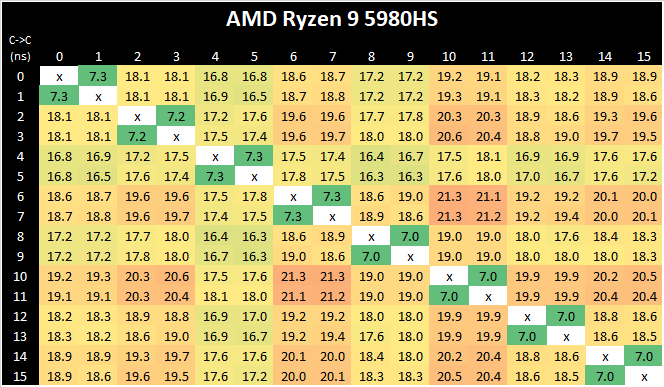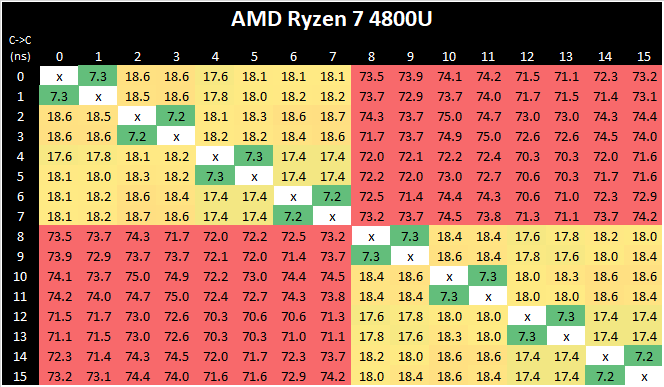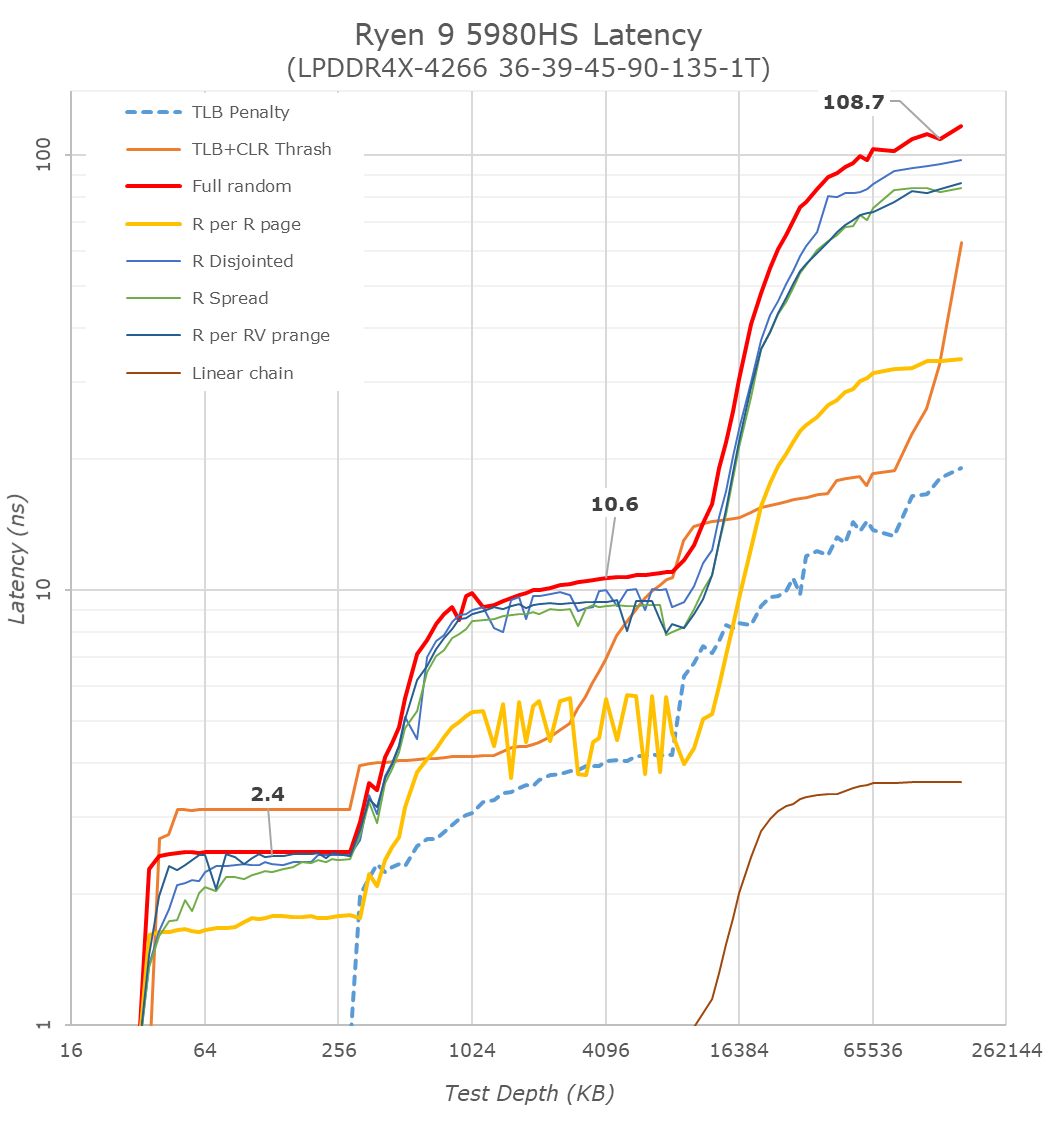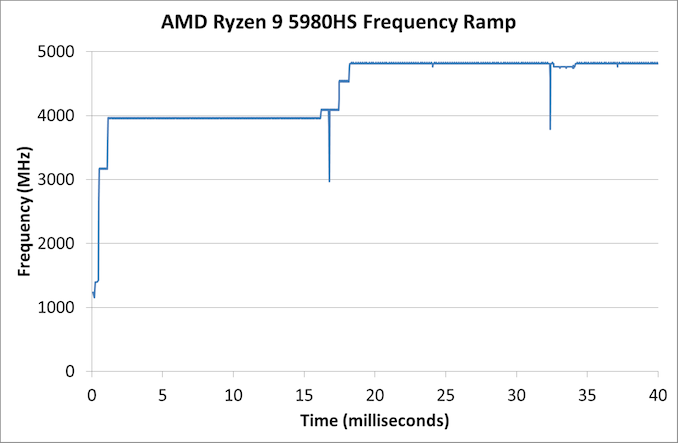AMD Ryzen 9 5980HS Cezanne Review: Ryzen 5000 Mobile Tested
by Dr. Ian Cutress on January 26, 2021 9:00 AM EST- Posted in
- CPUs
- AMD
- Vega
- Ryzen
- Zen 3
- Renoir
- Notebook
- Ryzen 9 5980HS
- Ryzen 5000 Mobile
- Cezanne
CPU Tests: Microbenchmarks
Core-to-Core Latency
As the core count of modern CPUs is growing, we are reaching a time when the time to access each core from a different core is no longer a constant. Even before the advent of heterogeneous SoC designs, processors built on large rings or meshes can have different latencies to access the nearest core compared to the furthest core. This rings true especially in multi-socket server environments.
But modern CPUs, even desktop and consumer CPUs, can have variable access latency to get to another core. For example, in the first generation Threadripper CPUs, we had four chips on the package, each with 8 threads, and each with a different core-to-core latency depending on if it was on-die or off-die. This gets more complex with products like Lakefield, which has two different communication buses depending on which core is talking to which.
If you are a regular reader of AnandTech’s CPU reviews, you will recognize our Core-to-Core latency test. It’s a great way to show exactly how groups of cores are laid out on the silicon. This is a custom in-house test built by Andrei, and we know there are competing tests out there, but we feel ours is the most accurate to how quick an access between two cores can happen.
AMD’s move from a dual 4-core CCX design to a single larger 8-core CCX is a key characteristic of the new Zen3 microarchitecture. Beyond aggregating the separate L3’s together for a large single pool in single-threaded scenarios, the new Cezanne-based mobile SoCs also completely do away with core-to-core communications across the SoC’s infinity fabric, as all the cores in the system are simply housed within the one shared L3.
What’s interesting to see here is also that the new monolithic latencies aren’t quite as flat as in the previous design, with core-pair latencies varying from 16.8ns to 21.3ns – probably due to the much larger L3 this generation and more wire latency to cross the CCX, as well as different boost frequencies between the cores. There has been talk as to the exact nature of the L3 slices, whether they are connected in a ring or in an all-to-all scenario. AMD says it is an 'effective' all-to-all, although the exact topology isn't quite. We have some form of mesh with links, beyond a simple ring, but not a complete all-to-all design. This will get more complex should AMD make these designs larger.
Cache-to-DRAM Latency
This is another in-house test built by Andrei, which showcases the access latency at all the points in the cache hierarchy for a single core. We start at 2 KiB, and probe the latency all the way through to 256 MB, which for most CPUs sits inside the DRAM (before you start saying 64-core TR has 256 MB of L3, it’s only 16 MB per core, so at 20 MB you are in DRAM).
Part of this test helps us understand the range of latencies for accessing a given level of cache, but also the transition between the cache levels gives insight into how different parts of the cache microarchitecture work, such as TLBs. As CPU microarchitects look at interesting and novel ways to design caches upon caches inside caches, this basic test proves to be very valuable.
As with the Ryzen 5000 Zen3 desktop parts, we’re seeing extremely large changes in the memory latency behaviour of the new Cezanne chip, with AMD changing almost everything about how the core works in its caches.
At the L1 and L2 regions, AMD has kept the cache sizes the same at respectively 32KB and 512KB, however depending on memory access pattern things are very different for the resulting latencies as the engineers are employing more aggressive adjacent cache line prefetchers as well as employing a brand-new cache line replacement policy.
In the L3 region from 512KB to 16 MB - well, the fact that we’re seeing this cache hierarchy quadrupled from the view of a single core is a major benefit of cache hit rates and will greatly benefit single-threaded performance. The actual latency in terms of clock cycles has gone up given the much larger cache structure, and AMD has also tweaked and changes the dynamic behaviour of the prefetchers in this region.
In the DRAM side of things, the most visible change is again this much more gradual latency curve, also a result of Zen3’s newer cache line replacement policy. All the systems tested here feature LPDDR4X-4266 memory, and although the new Cezanne platform has a slight advantage with the timings, it ends up around 13ns lower latency at the same 128MB test depth point into DRAM, beating the Renoir system and tying with Intel’s Tiger Lake system.
Frequency Ramping
Both AMD and Intel over the past few years have introduced features to their processors that speed up the time from when a CPU moves from idle into a high powered state. The effect of this means that users can get peak performance quicker, but the biggest knock-on effect for this is with battery life in mobile devices, especially if a system can turbo up quick and turbo down quick, ensuring that it stays in the lowest and most efficient power state for as long as possible.
Intel’s technology is called SpeedShift, although SpeedShift was not enabled until Skylake.
One of the issues though with this technology is that sometimes the adjustments in frequency can be so fast, software cannot detect them. If the frequency is changing on the order of microseconds, but your software is only probing frequency in milliseconds (or seconds), then quick changes will be missed. Not only that, as an observer probing the frequency, you could be affecting the actual turbo performance. When the CPU is changing frequency, it essentially has to pause all compute while it aligns the frequency rate of the whole core.
We wrote an extensive review analysis piece on this, called ‘Reaching for Turbo: Aligning Perception with AMD’s Frequency Metrics’, due to an issue where users were not observing the peak turbo speeds for AMD’s processors.
We got around the issue by making the frequency probing the workload causing the turbo. The software is able to detect frequency adjustments on a microsecond scale, so we can see how well a system can get to those boost frequencies. Our Frequency Ramp tool has already been in use in a number of reviews.
Our frequency ramp showcases that AMD does indeed ramp up from idle to a high speed within 2 milliseconds as per CPPC2. It does take another frame at 60 Hz (16 ms) to go up to the full turbo of the processor mind.














218 Comments
View All Comments
Lemnisc8 - Tuesday, January 26, 2021 - link
Can someone PLEASE find out if this thing is running in quad channel or dual channel lpddr4x. It’s already at a disadvantage since lpddr4x has half the bus width of standard ddr4. It would be fine if it ran in quad channel because it’s bus width would then be the same size as ddr4 at 128 bits, but no reviews anywhere show what channel configuration it’s running in...neblogai - Tuesday, January 26, 2021 - link
I don't think there were any 4000-series laptops running LPDDR4x just dual channel- I've only seen it to be quad-channel. So this flagship device (and used by AMD to impress about 5000H performance) should be no different.xza23 - Tuesday, January 26, 2021 - link
As always , excellent article , thank you!watzupken - Tuesday, January 26, 2021 - link
I feel with the introduction of Renoir, what blew most away is the fact that AMD managed to squeeze 8 cores into the U series. Not only that, the Zen 2 architecture also resulted a some serious uplift in performance as compared to the previous Zen+. This year round while it is all nice and good to see decent performance bump, the wow factor is not there. I am not expecting a core increase especially on the same N7 node, and to be honest, 8 cores is plenty of performance for a mobile PC.On the point of still using Vega, despite the age, Vega is still very competitive. One may argue that Intel's Xe graphics is better, but reviews out there proved otherwise. Xe is certainly fast, but both the iGPUs from AMD and Intel are likely memory bandwidith limited if one is pushing 1080p. Adding more cores will likely have diminishing returns. And honestly if you are a gamer, you cannot avoid getting a system with a dedicated GPU no matter how good the iGPU is.
Fulljack - Wednesday, January 27, 2021 - link
I agree, the R&D cost of moving from Vega to RDNA probably isn't worth it in the grand scheme of business.rumor has it that in 2022, Rembrandt will still leverage Zen 3 CPU but will use RDNA2 with DDR5 memory.
Ptosio - Wednesday, January 27, 2021 - link
Shouldn't it be pretty straightforward given that these APU already kind-of exist in the consoles?Hopefully Alder Lake would push AMD to offer best CPU/GPU combination they have!
As I understand, going to RDNA2 would also mean smaller core for the same performance? So there should be some savings in it for AMD as well.
Spunjji - Thursday, January 28, 2021 - link
"Shouldn't it be pretty straightforward given that these APU already kind-of exist in the consoles?"Those APUs use a totally different memory subsystem, much larger GPU slices, and they also use Zen 2 cores. AMD were specifically aiming to get Zen 3 out across their range - there's probably a lot of work needed to scale RDNA 2 down to iGPU levels without unbalancing its performance.
zamroni - Tuesday, January 26, 2021 - link
Amd should reduce Cezanne's core count to 6 then use the transistor budget for more gpu cores.That way it will beat all Intel laptop processors at all aspects
dicobalt - Tuesday, January 26, 2021 - link
Now they need to sell a version that cuts out the silly integrated graphics and uses a faster dedicated GPU. I don't understand the motivation for having a steroid pumped 8 core CPU paired with anemic integrated graphics. It seems AMD is more interested in selling the idea of APUs than actually providing a balanced system.Zizy - Wednesday, January 27, 2021 - link
AMD is clear that integrated GPU is for the very same chip at 15W. It is a pretty fine GPU there, TDP and bandwidth limit potential anyway. I wonder what is the die area saving by ditching GPU. If it is sizeable then yeah, it would be great to have a GPU-less variant of the chip, especially with current wafer supply issues.